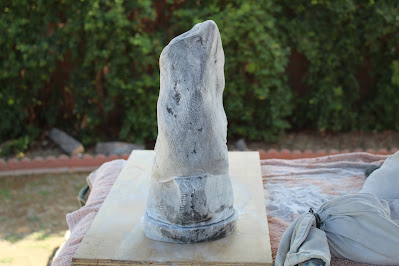Cracks n' Stuff
It sometimes happens that the fissures don't show up until a carving is well underway, and when that happens, it causes problems.
You might guess that this is what I'm dealing with right now. At least, with an abstract figure this means adjusting the shape in progress. There is always some room for improvisation. You can't do that with a bust, or a statue.
Uh, well, umm, yeah it's supposed to be a guy with no arm, and right shoulder. I planned that way to uhh- make a statement, that's it!
Enter Starbond. The super-glue that you get at the grocery store is watered down. Starbond is the real deal. It comes from Japan, and it's a little bit treacherous to work with. You can easily weld your fingertips to each other, or anything they may touch. It come with needle fine dispensing tips so you can drip it into a crack with some precision. Even so, the fluid is very thin and it runs all over the place before it sets up. If the fissure is fine enough, the Starbond can keep the edges from flaking, and keep the fissure from spreading and causing a chunk to fall out of the stone.
In this case, the crack is on the left side near the bottom where I've been shaping the butt end of the rock into a wedge. The Starbond is the wet looking patches. You can see the drip in the top pic as well. We'll just have to see how it works out. I may have the fissure under control here. If it continues to give me trouble I have the option of cutting much of the tail end away.
Again, this is the freedom that you have when working an abstract form. It doesn't mean anything goes. It is entirely possible to wreck the composition by hacking the wrong way. So now, it is time to slow down a little, give attention to other parts of the figure, and as always, spend a lot of time just staring at the stone.




I'm reminded of a lot of the videos I've seen where people combine resin with various other materials - usually wood, but could be lots of things - and then sculpt and shape it as one normally would depending on the parameters of the project. I wonder if something like that would work with alabaster?
ReplyDeleteI saw such a project in a video a while back. A guy had all these cubes of exotic hardwood glued together in the middle of a big block of clear resin. It was a cool idea. The blocks looked a little like the skyline of a city. Unfortunately what the guy carved was a whale. A whale is a smooth streamlined shape. The square blocky looking material sat perpendicular to the whale's body. It just didn't fit with the whale motif. No doubt something similar could be done with alabaster, and alabaster would be the perfect stone to do it with. Oh- note on Whittier museum, The upstairs hall is often open for events when the museum itself is closed.
ReplyDeleteI wondered about that - good to know.
ReplyDeleteRe. the resin, if you do a video search people are doing amazing things with the stuff. And some people are... well, very creative.
Oh, ho! I need to get some of that glue!
ReplyDeleteSo you follow the stone!?